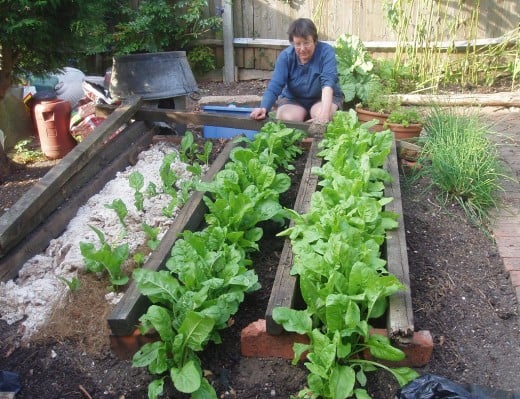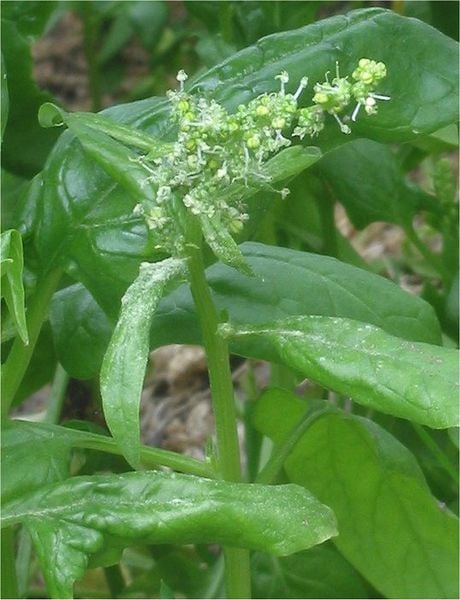What are the Benefits of Spinach
Where did Spinach Originate
By all accounts, spinach originated in Persia where it is referenced in writing at around 220 BCE. Arab traders brought it to Mediterranean where it was often called "Persian greens." Arab agronomists were masters at growing it in this hot relatively dry climate. Spinach made it's way to China via India in about 640 CE.
The word spinach has a long and varied history. It comes from Middle French espinache which came from old Provincial espinarc, which came from Catalonian espinac, which came from Arabic isbinakh, which came from Persian aspanakh. Aspanakh means "green hand" in Farsi.


Nutritional Value of Spinach
A three and a half ounce serving of spinach contains almost four grams of carbohydrate, 1/2 gram of sugar, 2 grams of dietary fiber, less than 1/2 a gram of fat and 2 grams of protein.
Spinach is also known to contain iron, but it is a form of iron that is poorly absorbed by the human body. (see below)
It's vitamin content is limited to vitamin A (1/2 the RDA) and B9. It also contains beta-cartoene (1/2 the RDA), lutein and zeaxanthin. Lutein is a known antioxidant and zeaxanthin is found in the retina of the eye.
Since both these compounds are similar the are often referenced together. Both compounds are known to help prevent macular degeneration (loss of sight) and may also help prevent the formation of cataracts.
The Calcium and Iron in Spinach
The iron in spinach is called non-heme iron. It is not well absorbed by the human body unless the consumer also has an adequate intake of both calcium and vitamin C. Despite this spinach also contains oxilates which naturally bind to iron thus preventing this mineral from being taken up in the human body.
Spinach is also rich in calcium, but once again the oxilates interfere with the uptake of this mineral in the body.
So if you are consuming spinach in the belief that it will provide you with the daily recommended allowance of iron or calcium you might want to consider another vegetable.
However, if you need vitamin A or beta-carotene, spinach is for you. A mere three and a half ounces provides half the RDA of both of these.
Popeye the Sailor
Not everyone will know or maybe even remember this, but there was a cartoon character created in 1929 who was known for his prodigious strength after eating spinach. His name was Popeye the Sailor, a fitting name since he always had one eye closed, and he was part of American culture for almost seventy years.
There was a rumor going around that the consumption of spinach was based on an erroneous belief that it contained ten times the iron that it actually had. This, supposedly, when a German scientist misplaced a decimal point and attributed ten times the actual iron content to spinach.
Research has not been able to find this error nor is there any evidence that Popeye's creator referenced the iron in the vegetable or made any sort of claim that this iron was the source of Popeye's strength.
What is known is that Elzie Crisler Segar knew that many children did not like it and wanted to find a popular way to promote its consumption and not for it's iron content, but rather for it's vitamin A content.
Segar introduced spinach to Popeye (and his young readers) during the US Infant Nutrition Crises of the 20s and 30s.
On Popeye Segar said: "Popeye's life has been a sad one and I claim that pathos is the best background for humor. Tragedy and comedy are so closely related that it is only a step from one to the other."
During the 30s Popeye was credited with a 33% increase in the consumption of spinach.
Choosing Spinach
Most canned spinach, even by the big brands, tends to have a lot of "woody" stem within it along with the leaves. Since what's in the can was cooked quite a while to get it soft most of the nutrients are still there, but it's mushy and often over-salted. Not very appetizing.
Fresh spinach is much better. It looks better, is far more tender, and, since you will do most of the preparation, you control the mineral and vitamin content; not the canning company.
Look for healthy bright green leaves with no wilting. Spinach by the bag is a good choice, but remember to use it within a couple days of purchase. Spinach will spoil pretty quickly, even in a bag in the vegetable crisper.
Less than Usual Spinach Recipes
Wilted Spinach and Wine
Ingredients
- 3 Tablespoons butter, cut into small pieces
- 1 1/2 Pounds triple washed, coarsely chopped, stem-less spinach
- 2 Cloves garlic, pressed or mashed
- 2 pinches of salt
- 1/2 Cup dry white wine
- Salt and pepper
Directions
- Heat a medium sized skillet over medium heat. Allow the pan to become hot.
- Mince or mash your garlic cloves. Or use a garlic press.
- With the flat side of your
knife, make a garlic paste with smashed garlic and two pinches of salt.
- Add butter to pan.
- Add garlic paste to the pan. Stir to prevent burning.
- Add the spinach in bunches, adding
more spinach to the pan as it wilts down.
- When all of the spinach is
wilted, add wine and turn the spinach to coat.
- Let wine cook down a minute or two.
- Season spinach with salt and pepper and serve.
Saag Panir (East Indian Spinach)
Ingredients
- 3 Tablespoons Butter
- 1 medium Onion diced
- 2 Garlic cloves, minced
- 1 Tablespoon Curry powder
- 1/2 teaspoon Cinnamon ground
- 1 teaspoon Coriander powder - ground
- 1/4 teaspoon Cayenne pepper - optional
- 1 cup Yogurt - low fat
- 3/4 Cup Non-Fat Half and Half
- 20 Ounces Spinach - frozen
- 15 Ounces Garbanzo beans drained and rinsed
- 1/2 Pound Cheese - Panir , cut into small
Directions
- Place spinach in food processor and process
until smooth.
- Squeeze out excess liquid.
- Heat butter in a skillet over medium heat.
- Add onion and saute
until translucent.
- Season with salt and pepper, to taste.
- Add garlic and
cook for another minute.
- Add spices and cook until fragrant.
- Add
yogurt, half-and-half, spinach, and drained chickpeas.
- Bring to a simmer
over medium heat and cook until heated through.
- Add cheese cubes and continue heating until cheese is warm but not melted.
If you can't find Panir any mild white cheese may be used. You can also leave the cheese out of the dish if desired.










